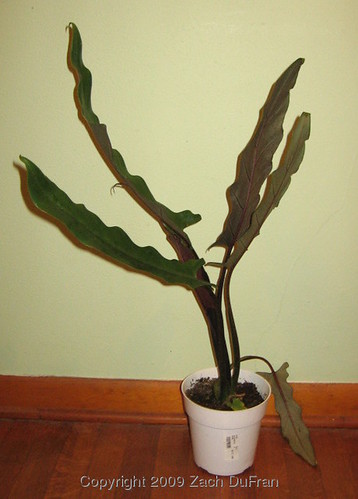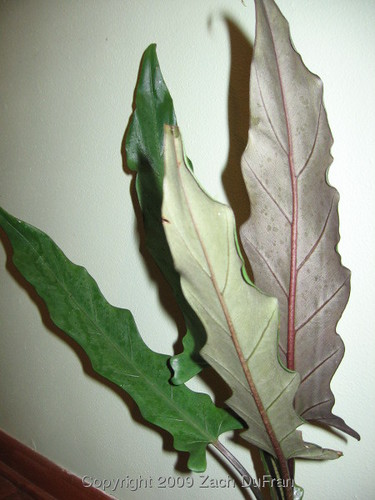My wife and I took a short road trip on Sunday to visit a nearby church where one of my good friends is now the associate pastor. On our way back home, we happened to pass one of my favorite local plant stores, TLC. (No, really, I didn't realize we were going to be driving right past it.)
Anyway, as you can guess, we stopped in to see what they had. I kept mental notes of plants that were on my "want to buy" list and then, after seeing the whole store, decided to purchase one of them. The plant I chose is an Alocasia which I had never seen before and was right up my alley.
Alocasias are one of the genera that are commonly called as "elephant ears." Well, some of them are. I would be surprised if anyone called this particular plant an elephant ear! Other genera that use the "elephant ear" common name are Colocasia and Xanthosoma - and maybe a couple of others. Colocasia and Alocasia are often hard to tell apart, but I have recently heard some good ways to tell them apart. Alocasias almost always have stems that attach to the edge of the leaves, while Colocasia stems usually attach in the middle of the leaf. This leaf attachment is known as peltate.
Alocasia lauterbachiana has beautiful leaves that are dark green on top and purple underneath. The leaves are quite long, slender and lance-shaped, pointing upwards and they are marginally-attached. That is, the stem that holds the leaf attaches at the edge of the leaf.
While this is the more common way for Alocasia leaves to be attached, some Alocasias have peltate leaves like most of the Colocasias do. Some notable peltate Alocasias are A. cuprea, A. clypeolata and A. rugosa. I'm planning on posting soon on the anatomy of plants from the Aroid (Araceae) family. There is quite a bit of vocabulary that is unique to this family. My post would include vocabulary referring to leaf structure, parts of leaf, as well as the unique "blooms" of the Aroid family.
I have read that this plant is sort of sensitive and does not like to be repotted or moved around much. I will be moving it into my greenhouse next week, assuming all goes well, and it should be content in its stable growing environment.
Anyway, as you can guess, we stopped in to see what they had. I kept mental notes of plants that were on my "want to buy" list and then, after seeing the whole store, decided to purchase one of them. The plant I chose is an Alocasia which I had never seen before and was right up my alley.
 |
| Alocasia lauterbachiana |
 |
| close up of Alocasia lauterbachiana leaves |
While this is the more common way for Alocasia leaves to be attached, some Alocasias have peltate leaves like most of the Colocasias do. Some notable peltate Alocasias are A. cuprea, A. clypeolata and A. rugosa. I'm planning on posting soon on the anatomy of plants from the Aroid (Araceae) family. There is quite a bit of vocabulary that is unique to this family. My post would include vocabulary referring to leaf structure, parts of leaf, as well as the unique "blooms" of the Aroid family.
I have read that this plant is sort of sensitive and does not like to be repotted or moved around much. I will be moving it into my greenhouse next week, assuming all goes well, and it should be content in its stable growing environment.
A relative of elephant years. Some species come in so many varieties. Makes plant shopping really exciting.
ReplyDeleteNice plant. I had an Elephant ears once, but it didn't last long. Will you plant it outside in spring?
ReplyDeleteWhat a lovely plant. Alocasia is a tropical plant, they need a lot of sunshine and good watering. Alocasia grows wildly in my place & its considered a weed.
ReplyDeleteHow fascinating. I would never have thought it an Alocasia but just shows again how complex and variable they can be.
ReplyDeleteLove the look of this plant! Will it die back, as elephant ears do or continue growing and putting out new leaves?
ReplyDeleteJust acquired one myself. A Gift store lady at Bok Tower was able to ID it for me. BUT - I still can not find a COMMON NAME for it.
ReplyDeleteCan anyone help?
I believe the common name is Purple Sword.
ReplyDelete